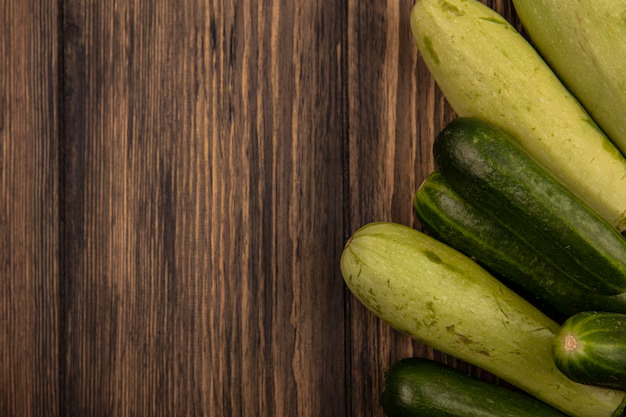Keeping Cucumbers Fresh: Your Essential Guide to Refrigerator Storage
When it comes to fresh produce, cucumbers are a versatile and refreshing favorite. Whether you're slicing them into salads, pickling them for tangy snacks, or blending them into smoothies, ensuring that cucumbers remain crisp and flavorful is essential. Yet, storing them properly can often be a source of confusion. Let's dive into the best practices for storing cucumbers in your refrigerator to maximize their shelf life and taste.
🥒 Understanding Cucumbers: Characteristics and Storage Challenges
Cucumbers, beloved for their hydrating properties and mild taste, are about 96% water. While this high water content makes them wonderfully refreshing, it also means they can quickly become mushy or spoil if not stored correctly. Therefore, understanding and addressing the specific needs of cucumbers is key to maintaining their freshness.
🌡️ Optimal Temperature and Humidity
Cucumbers thrive in a specific environment:
- Temperature: Ideally, store cucumbers at temperatures between 50-54°F (10-12°C) to maximize their longevity. However, since home refrigerators are usually set to around 37°F (3°C), it's important to find a balance.
- Humidity: Cucumbers prefer a high-humidity environment to prevent dehydration.
🥶 Refrigeration Considerations
Do: Store cucumbers in the crisper drawer, which often has higher humidity than the rest of the fridge. Positioning them away from the refrigerator walls can also help prevent them from getting too cold, as full contact with surfaces can lead to chilling injury.
Don't: Keep cucumbers near ethylene-producing fruits like bananas, tomatoes, or melons, which can speed up spoilage.
🥗 Preparing Cucumbers for Storage
Before placing cucumbers in the refrigerator, a little preparation goes a long way.
🍴 Washing and Drying
While washing cucumbers before use is standard, it's often better to store them unwashed. Any leftover moisture from washing can encourage mold growth. Instead, wash and dry cucumbers thoroughly just before you're ready to use them.
📦 Packaging
Proper packaging is crucial for cucumber storage:
- Plastic Wrap or Bags: Wrapping cucumbers in paper towels and then placing them in a plastic bag can help to maintain moisture without making them overly damp.
- Reusable Produce Bags: These allow airflow while slightly preserving moisture levels, an eco-friendly alternative to plastic.
🗂️ Pre-Slicing and Storage
If you prefer convenience, cucumbers can be pre-sliced and stored in an airtight container. Line the container with paper towels to absorb excess moisture, preventing slices from becoming slimy.
✨ Enhancing Cucumber Longevity: Tips and Tricks
Even when stored at cooler temperatures, cucumbers can suffer from chilling injuries, leading to wateriness and pitting. Applying the right techniques can mitigate these risks.
🍋 Use Nature’s Preservatives
Adding a squeeze of fresh lemon juice or vinegar before packing cucumbers can act as a natural preservative, adding a slight edge of flavor while increasing their shelf life.
🌿 Consider the Company
Cucumbers can peacefully coexist with other veggies that have similar storage requirements:
- Companions: Pair with lettuce or herbs, which also benefit from high humidity. Separating compartments in the crisper drawer can help group similar items together.
🕰️ Timing and Rotation
Plan to consume cucumbers within a week or so of refrigeration. Practice the 'first-in, first-out' rule to keep track of the oldest cucumbers and use them first.
🍽️ Creative Ways to Use Cucumbers Before They Spoil
If you're concerned that cucumbers are getting too ripe, consider these culinary options to ensure they don't go to waste:
- Pickling: A delicious way to use up cucumbers quickly.
- Smoothies: Adding cucumbers to smoothies enhances their nutritional value and gives them a refreshing taste.
- Soups: Cold cucumber soup is a staple in many hot climates—perfect for refreshing hors d'oeuvres.
🔍 Quick Reference: Cucumber Storage Checklist
Here's a handy list to keep your cucumbers fresh:
- ✅ Storage Location: Crisper drawer in high humidity section.
- ✅ Packaging: Wrapped in paper towels, inside a plastic or reusable bag.
- ✅ Separation: Keep away from ethylene-producing fruits.
- ✅ Pre-Use: Wash, dry, and slice just before eating.
- ✅ Creative Solutions: Consider pickling or soup if nearing spoilage.
Dove Deeper: Addressing Common Cucumbers Myths
Myth 1: Cucumbers Don’t Belong in the Fridge
While cucumbers can suffer from chilling injury when stored at temperatures lower than their optimal range, storing them in the fridge is generally safe if carefully managed through proper packaging.
Myth 2: You Can Store Cucumbers with Anything
As mentioned, cucumbers are sensitive to ethylene gas, which speeds up ripening. Storing them with ethylene-producing fruits can result in premature spoilage.
Myth 3: Sliced Cucumbers Always Spoil Quickly
When properly stored, sliced cucumbers can retain their freshness. However, the key lies in airtight packaging with minimal moisture.
🌟 Summing It All Up
Storing cucumbers in the refrigerator can be straightforward and reliable with a few guided steps. By keeping storage places like the crisper drawer, packaging materials like paper towels and bags in mind, and pairing cucumbers wisely, you can extend their freshness and enjoy their crispness longer.
As you adopt these strategies, you'll find cucumber storage transforming from a challenge into an easy task, making your salads, snacks, and meals consistently crisp and delightful. Remember, attention to detail in storage can surprisingly enhance both taste and longevity. Keep these tips in mind, and enjoy every refreshing bite!
